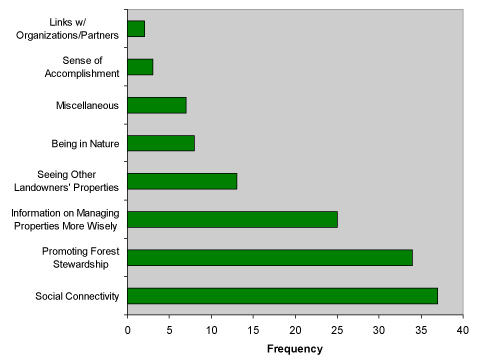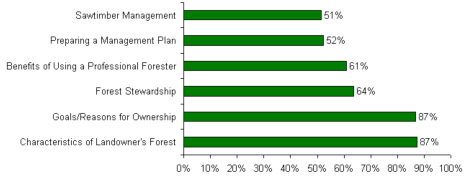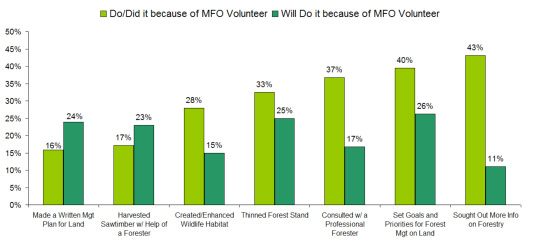 |
October 2011
|
October 2011 // Volume 49 // Number 5 // Research In Brief // v49-5rb3
Evaluating Peer Impacts of a Master Forest Owner Volunteer Program
Abstract
The study reported here evaluated the outcomes of the New York Master Forest Owner Program by measuring both internal volunteer impacts as well as volunteer impacts on woodland owners visited through the program. Internal impacts allowed volunteers to manage their own properties better, promote forest stewardship in their community, and take on increased leadership roles. External impacts resulted in increased information-seeking and goal-setting behaviors as well as on the ground management activities. The results from the surveys demonstrate that local peer-to-peer programs can positively influence woodland owners in their communities as well empower the volunteers themselves.
Introduction
Adult volunteer conservation outreach programs have become increasingly prevalent within the past 30 years. Of particular interest are the wealth of "Master" volunteer programs based upon the successful Master Gardener program model, such as those focused on watershed stewardship, composting, forestry, and ecology (Van Den Berg, Dann, & Dirkx, 2009). Adult volunteer conservation outreach programs often have impacts at two levels: the individual volunteer and those reached by the outreach activities of the volunteer. New York's Master Forest Owner volunteer program was initiated in 1991 and was modeled after the successful COVERTS programs in Massachusetts and Connecticut funded by the Ruffed Grouse Soceity. The focus of the evaluation research reported here was to assess both the impacts on volunteer participants as well as the impacts to those reached through the volunteer network.
For internal volunteer impacts, data comparisons from pre-training and post-training knowledge tests consistently indicate increased content understanding, with scores improving on average by 15% (Bonneau, Darville, Legg, Haggerty, & Wilkins, 2009; Van Den Berg & Dann, 2008). The increase in conservation knowledge resulting from program involvement often led volunteers to implement a number of management techniques on their own properties. For example, after training, 92% of Maine Master Gardener respondents adopted six or more of the 16 practices taught, and 42% indicated learning specific horticultural skills as the most significant benefit of the program (Peronto & Murphy, 2009). Similarly, Texas Master Naturalist participants indicated personal growth and learning opportunities as the largest benefits derived, followed by community service opportunities and the opportunity to be involved with resource professionals (Bonneau et al., 2009).The most significant volunteer motivations to participate in "Master" volunteer training programs is practical classroom instruction and hands-on experience, along with value-related benefits, such as contributing to community growth and development (Broun, Nilon, & Pierce 2009; Schrock, Meyer, Ascher, & Snyder, 2000; Van Den Berg, Dann, & Dirkx, 2009). Social and career motivations played lesser roles in volunteer program involvement (Broun, Nilon, & Pierce, 2009; Schrock et al. 2000).
One study went beyond individual volunteer impacts to examine external impacts. Master Forest Owner Volunteer programs in NY, CT, and PA were evaluated via a mail survey of landowners who were visited by a Master Forest Owner (MFO) Volunteer between 1991 and 1997 (Broderick, Milici, Snyder, Goff, & Finley, 1999). Because of an MFO visit, forest owners reported joining conservation organizations or seeking out information on forest management, implementing wildlife management practices, preparing a written management plan, and selling timber with the assistance of a professional forester.
While much of the research on adult volunteer conservation outreach programs has been devoted to documenting the experience of volunteers, there is a need to investigate the impacts beyond the individual volunteers that accrue to the broader network of those people reached by the volunteers. The research reported here explored this idea further within the context of the New York Master Forest Owner Volunteer program. Internal benefits help MFO Volunteers by improving their content knowledge, organizational and leadership skills, and ability to manage their land more effectively. External impacts represent broader impacts and benefits to other woodland owners by providing enhanced information for better decision-making. The research reported here provides the results of the MFO Program's internal and external impacts.
About the Master Forest Owner Volunteer Program
The New York Master Forest Owner (MFO) Volunteer program was instituted in 1991 by Cornell University with the goal of training woodland owners in the principles of forest stewardship primarily to motivate other woodland owners to become actively involved in their forestland and secondarily to better equip them to manage their own woodlands (Goff & Muth, 2006). The program follows the empowerment theory, in which the skills of individuals are developed to enact broader positive change (Westphal, 2003). MFO Volunteers receive certification following a 4-day, 40-hour training session covering numerous forestry-related topics, such as wildlife management, forest economics, ecology, and related programs and organizations. Most MFO volunteers are longtime forest owners, and thus the training complements their experience. Following certification, "empowered" MFO Volunteers are encouraged to spread their knowledge and skills to others and promote forest stewardship ethics.
The mechanisms by which MFO Volunteers fulfill the goals of the program include conducting on-site visits with other forest owners, collaborating with agencies and organizations on forestry educational events, and preparing forestry articles for media outlets. The program relies on peer learning strategies as well as landowner networks in achieving program goals (Broussard & Goff, 2009).
Research Methods
In May 2008, a pre-tested survey was distributed to two groups: 1) New York Master Forest Owner Volunteers (N=150) and 2) woodland owners receiving an on-site visit from an MFO Volunteer between 1999-2008 (N=584). Active MFOs were surveyed via a combined web and mail survey. Up to four reminders were sent following the invitation to complete the survey. The survey URL was sent by email to those MFO Volunteers with email addresses (n=96) on file with the MFO program, and a mail survey (n=54) was sent to those with only postal addresses on file.
The sample for the survey of forest landowners visited by an MFO Volunteer was obtained from on-site visit reports submitted by MFO Volunteers to the Program Director over the years 1999-2008. On-site visits consist of discussion-oriented "woodswalks" where the MFO Volunteer goes to another woodland owner's property or vice versa.
The response rate for the MFO Volunteer survey was 65% (n=95) and 56% (n=270) for the survey of woodland owners visited by an MFO Volunteer. A non-response bias analysis was not conducted for the woodland owner survey population, and one was not needed for the MFO volunteer survey because we surveyed the entire population and were not generalizing from a sample. For the exact survey question wording readers can consult a copy of the survey instrument used in this research, which can be found at the Cornell University Human Dimensions Research Unit Website in the report titled "An Evaluation of the NY Master Forest Owner Volunteer Program: Survey of Woodland Owners Visited by a NY Master Forest Owner Volunteer" <http://www2.dnr.cornell.edu/hdru/pubs/HDRUReport09-7.pdf>.
Internal Volunteer Program Impacts
MFO Volunteers are exposed to a range of experiences and information through their training and outreach activities. One aim of the MFO Program is to encourage involvement in conservation organizations. Since their certification, 76% of MFO Volunteers surveyed have assumed at least one leadership role. Respondents have joined a number of organizations, at least in part because of their involvement in the MFO Program. Among the most common organizations that MFO Volunteers have become members of since certification are the New York Forest Owners Association, wildlife organizations such as the Audubon Society and Pheasants Forever, and the American Tree Farm System. The MFO Program helps to expand the knowledge of Volunteers and allows them to better manage their property. Respondents have utilized this information in a variety of ways, most commonly through conducting timber stand improvements, creating or enhancing habitats for wildlife, managing invasive species and pests, preparing a written management plan, and building and maintaining trails or access trails (Table 1).
| Activity | (n) | Activity | (n) | |
| Timber Stand Improvement | 36 | Harvested Firewood | 7 | |
| Created or Enhanced Habitat for Wildlife | 25 | Miscellaneous | 7 | |
| Invasive Species/Pest Management | 17 | Strategy for Planting New Trees | 4 | |
| Prepared a Written Management Plan | 16 | Arranged Timber Sale | 4 | |
| Built/Maintained Trails or Access Roads | 14 | Best Management Practices | 3 | |
| Use of Ponds and Wetlands | 14 | Enrolled in Forest Tax Law 480-a | 3 | |
| Consulted with Prof. Forester or Org. | 13 | Forest Regeneration | 3 | |
| Crop Tree Management | 10 | Managed Sugarbush/Sold Maple Prod. | 3 | |
| Tree Identification | 10 | Reinforced Forestry Education | 3 | |
| Property Boundary Establishment | 8 | Brush Management | 2 | |
| Beech Management | 7 | Hunted/Fished on Own Forestland | 2 | |
| Cultivation of Non-Timber Forest Products | 7 | Leased Hunting/Recreation Rights | 2 | |
| Education and Communication Skills | 7 | Planted or Sold Christmas Trees | 2 | |
| General Awareness of Woodlot Mgmt. | 7 | Estate Planning | 1 |
MFO Volunteers were asked to rate the value of the MFO program in achieving certain goals (Table 2). The majority of MFOs surveyed consider the program extremely valuable in helping them make wise management decisions on their own property and in promoting forest stewardship throughout their community. Respondents found the MFO program moderately to extremely useful in getting to know other forest landowners in their community. Very few respondents indicated that the MFO Program was "not very valuable" or "not at all valuable" for fulfilling these objectives.
| Not
at all Valuable % (n) | Not
Very Valuable % (n) | Neutral % (n) | Moderately
Valuable % (n) | Extremely
Valuable % (n) | Mean Rating* | |
| Making Wise Management Decisions | 1.1% (1) | 1.1% (1) | 10.6% (10) | 23.4% (22) | 63.8% (60) | 4.48 |
| Promoting Forest Stewardship | 0.0% (0) | 0.0% (0) | 6.5% (6) | 39.8% (37) | 53.8% (50) | 4.47 |
| Getting to Know Other Forest Owners | 0.0% (0) | 4.4% (4) | 16.5% (15) | 40.7% (37) | 38.5% (35) | 4.13 |
| * 1=Not at all Valuable, 5=Extremely Valuable | ||||||
The MFOs surveyed also described what aspects they like most about being a MFO Volunteer. The results shown in Figure 1 demonstrate a range of social, informational, and stewardship benefits. For many respondents (39%, n=37) the social connectivity gained through forest visits, meetings, and other interactions within the forestry community was their favorite part of being an MFO. The ability to promote forest stewardship, such as inspiring better management practices and instilling a love of the land, is another very popular aspect of the MFO program (34%, n=36). Many respondents (26%, n=25) valued most the insights they gained from the MFO program which they use to manage their own properties more wisely.
Figure 1.
Favorite Aspects of Being an MFO Volunteer

External Volunteer Program Impacts
On-site visits with area landowners are one of the primary means by which MFO Volunteers execute the mission of the Program. During these visits, MFO Volunteers interact with other woodland owners in their community to encourage forest stewardship.
Woodland owners were asked to rate the quality of their interactions with MFO Volunteers. On a 5-point scale from strongly disagree to strongly agree, approximately two-thirds of the woodland owners strongly agreed that the MFO was worthy of recommendation to other forest owners (68.3%, n=143), that the MFO was credible (65.9%, n=128), and that the interactions were enjoyable (61.8%, n=136). The most commonly discussed topics during the woodswalks were the characteristics of the landowner's forest, the goals and reasons for owning woodland, forest stewardship, and the benefits of using a professional forester (Figure 2).
Figure 2.
Topics of Discussion Between
Woodland Owners and MFO Volunteers (n=222)

Respondents were asked if the MFO Volunteer interaction had any impact on subsequent decisions or behavior concerning their woodland property. MFO Volunteers had the most influence in helping other woodland owners seek out more forestry information, set goals and priorities for forest management on land, consult with a professional forester, and thin forest stands (Figure 3).
Figure 3.
Woodland Owner Decisions
Influenced by MFO Volunteers (n=210)

Additionally, 31% (n=64) of respondents reported economic benefits through the influence of MFO Volunteers. MFO Volunteers helped them gain or save an approximate total of $258,715 through actions such as learning about and enrolling in a cost-share program, making a wise equipment purchases, selling firewood, or working with a professional forester to conduct a timber sale. For example, after visits by MFO Volunteers, 36 landowners earned an average of $9,778 more by selling timber for a higher price than they would have otherwise.
Conclusions
The MFO Program empowers MFO Volunteers to make wise management decisions regarding their forested property and to promote forest stewardship in their communities. MFO Volunteers help other forest owners better manage their woodlands by providing helpful advice and information regarding forestry topics, which can lead to improved woodland health and economic benefits. MFOs had the greatest influence on other woodland owners in seeking out more forestry information, setting goals and priorities for forest management on land, consulting a professional forester, and thinning forest stands.
Sixteen percent of surveyed woodland owners indicated that they have already developed written management plans for their land because of their contact with an MFO Volunteer. This is significantly higher than the percent of woodland owners with management plans in the state of New York (1.7%) and the entire United States (3.7%) (Butler et al., 2009). Woodland owners also reported economic benefits through the influence of MFOs, most frequently by selling timber for higher prices. MFOs consider the MFO program to be extremely valuable to make wise management decisions, promote forest stewardship, and getting to know others.
The results of the research reported here demonstrate that local peer-to-peer programs can have positive influences on woodland owners in their communities. The implications of the research are wide-reaching and relevant to other peer programs focused on forest stewardship that operate in states across the U.S. Peer outreach programs make it possible to both empower volunteers and have a broader external impact on informed decision-making about forestlands.
References
Bonneau, L., Darville, R., Legg, M., Haggerty, M., & Wilkins, R. N. (2009). Changes in volunteer knowledge and attitudes as a result of Texas Master Naturalist training. Human Dimensions of Wildlife, 14, 157-172.
Broderick, S., Milici, F., Snyder, L., Goff, G., & Finley, J. (1999). Reaching private woodland owners through Coverts: How are we doing? Ruffed Grouse Society Magazine. 11(3), 24-25, 32.
Broun, C. N., Nilon, C. H., & Pierce II, R. A. (2009). An evaluation of the Missouri Master Naturalist Program and implications for program extension. Journal of Extension [Online], 47(3) Article 3FEA5. Available at: http://www.joe.org/joe/2009june/a5.php
Broussard Allred, S., & Goff, G. (2009). The power of peer learning programs in natural resources. Cornell University Community and Rural Development Institute (CARDI) Rural New York Minute 32. Retrieved from: http://devsoc.cals.cornell.edu/cals/devsoc/outreach/cardi/publications/upload/08-2009-RNYM.pdf
Butler, B. J, Miles, P. D., & Hansen, M. H. (2009). National Woodland Owner Survey Tabler web-application version 1.0. Amherst, MA: U.S. Department of Agriculture, Forest Service, Northern Research Station. Retrieved from: http://fiatools.fs.fed.us/NWOS/tablemaker.jsp
Goff, G., & Muth, A. (2006). Yours for the asking......Peer assistance for forest owners. Small Farms Quarterly Winter 2006, 16-17.
Goff, G. (2008). NY Master Forest Owner/COVERTS Program. 2008 Program Year Newsletter. Available atRetrieved from: http://www.dnr.cornell.edu/ext/mfo/newsletters.htm
Peronto, M., & Murphy, B. (2009). How Master Gardeners view and apply their training: a preliminary study. Journal of Extension [On-line], 47(3) Article 3RIB2. Available at: http://www.joe.org/joe/2009june/rb2.php
Schrock, D. S., Meyer, M., Ascher, P., & Snyder, M. (2000). Benefits and values of the Master Gardener Program. Journal of Extension [On-line], 38(1) Article 1RIB2. Available at: http://www.joe.org/joe/2000february/rb2.php
Van Den Berg, H. A., & Dann, S.L . (2008). Evaluation of an adult extension education initiative: The Michigan Conservation Stewards Program. Journal of Extension [On-line], 46(2) Article 2RIB1. Available at: http://www.joe.org/joe/2008april/rb1.php
Van DenBerg, H.A ., Dann, S. L., & Dirkx, J. M. (2009). Motivations of adults for non-formal conservation education and volunteerism: Implications for programming. Applied Environmental Education and Communication, 8, 6-17.
Westphal, L. (2003). Urban greening and social benefits: A study of empowerment outcomes. Journal of Arboriculture, 29(3), 137-147.




